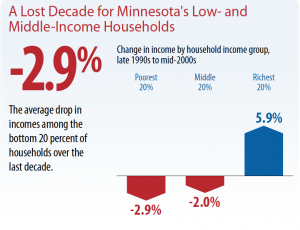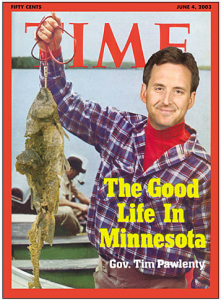If the new DFL-controlled Legislature dares to raise the minimum wage, strengthen the social safety net or make the state tax system more progressive, reporters will surely characterize the moves as political payoffs to DFL constituencies. Mainstream news reporters have fallen into a habit of covering policymaking like it is nothing more than a politically motivated auction of gifts for special interest.
To be sure, those policies help traditional DFL constituencies, and political motives are very much in the mix. But beyond crass vote-buying, there is also a pretty darn good reason to help low- and middle-income Minnesotans.
 Minnesota is increasingly becoming a land of haves and have nots. From the late 1990s to the mid-2000s, the Center on Budget and Policy Priorities notes that poorest Minnesotans have seen their incomes decrease by 3%, the middle quintile has experienced a 2% decline, and the wealthiest have enjoyed an increase of about 6%. Therefore, Minnesota’s income inequality gap has been growing.
Minnesota is increasingly becoming a land of haves and have nots. From the late 1990s to the mid-2000s, the Center on Budget and Policy Priorities notes that poorest Minnesotans have seen their incomes decrease by 3%, the middle quintile has experienced a 2% decline, and the wealthiest have enjoyed an increase of about 6%. Therefore, Minnesota’s income inequality gap has been growing.
As a result, Minnesota now has a “Top-to-Bottom Ratio” that is worse (i.e. a larger gap between rich and poor) than Iowa, Utah, Wyoming, Vermont, New Hampshire, Wisconsin, Nebraska, Idaho, Maine, Arkansas, Hawaii, Montana, South Dakota, Alaska and Oregon.
That’s a very ominous sign, because income inequality impacts upward mobility. White House Chairman of the Council on Economic Advisors Alan Krueger recently did an analysis showing that if the United States doesn’t get inequality under control, the next generation will see a 25% decrease in upward mobility compared to the current generation.
In other words, we’re witnessing the demise of the American Dream. That may sound melodramatic, but it is demonstrably true. Increasingly, it is looking like comedian George Carlin was prophetic when he quipped “”it’s called the American dream because you have to be asleep to believe it.”
The American Dream hasn’t always been a nightclub act punchline. Horatio Alger gushed about it in his “rags to riches” stories. In 1931, historian James Truslow Adams wrote glowingly about the American Dream of upward mobility, observing that “It is a difficult dream for the European upper classes to interpret adequately…”
But 90 years later, the Center for American Progress shows that the American Dream actually is much more alive in Europe than in the United States:
“By international standards, the United States has an unusually low level of intergenerational mobility: our parents’ income is highly predictive of our incomes as adults. Intergenerational mobility in the United States is lower than in France, Germany, Sweden, Canada, Finland, Norway and Denmark. Among high-income countries for which comparable estimates are available, only the United Kingdom had a lower rate of mobility than the United States.”
 So let’s recap: The American Dream is less alive in the United States than in France, and — hold onto your Pike, Wendy Anderson — less alive in Minnesota than in Arkansas.
So let’s recap: The American Dream is less alive in the United States than in France, and — hold onto your Pike, Wendy Anderson — less alive in Minnesota than in Arkansas.
Are you okay with that, Minnesota?
So, when Governor Mark Dayton proposes a more progressive taxation system, Senator Tom Bakk argues for a higher minimum wage and Representative Tom Huntley proposes ways to repair our social safety net, maybe it’s not merely, as Governor Romney would say, “gifts” to buy votes. Maybe it’s something more noble, like the restoration of Minnesota’s version of the American Dream.
– Loveland
Note: This post was also featured in Politics in Minnesota’s Best of the Blogs and as a “best of the best” in MinnPost’s Blog Cabin.
